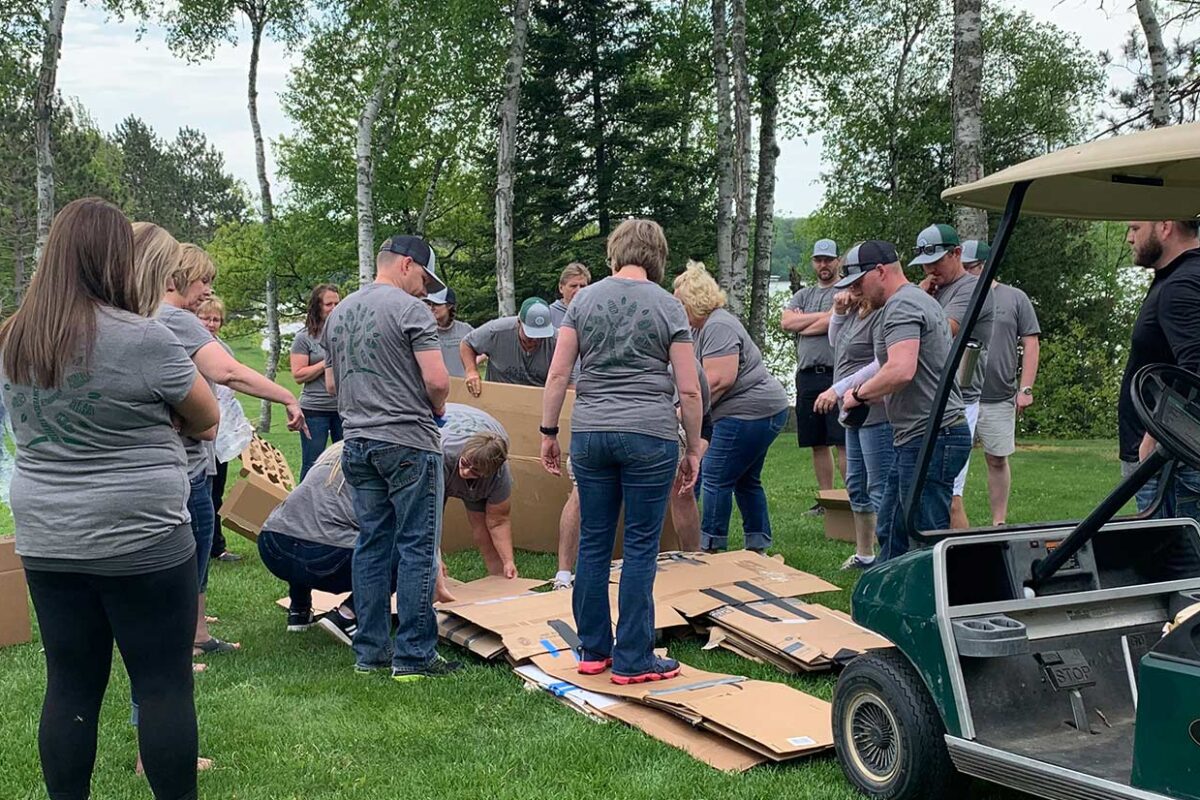Gather around! It’s time for team building. First, we want everyone to take one shoe off and place it in a pile. Then, every person is going to grab a shoe that is not theirs and traverse the room trying to find the person it belongs to.
Sound familiar? The shoe scramble (yes, it’s a real game) is just one of many corporate ice breakers that masquerades as a team building challenge for unsuspecting employees at company meetings and retreats. It’s mindless, unhelpful, and it stinks (with all the shoes taken off, this is a literal possibility).
It’s not that we hate ice breakers; they have their uses. It’s just that they don’t make effective team building exercises. Whether you’re a rank-and-file employee or lead of a business of your own, you’ve probably been put in one of these embarrassing situations. The corporate world can be rife with them, and they are the result of bad leadership retreats from facilitators and groups that don’t truly understand the purpose of team building exercises.
What is the True Purpose of Team Building? The One That’s Actually Helpful
If you’re under the impression that team building is the process of getting your team to know each other, you’re doing it all wrong. If you want to do that, host an event and let the team bond over food and drinks.
Team building is the process of developing a professional team that can strategize and operate well within a given space. It gets teams to a position where they can problem solve effectively, act decisively, operate independently, and think creatively. It creates a team that is more than just people who work together, instead building a cohesive unit that accomplishes the tasks set before them with efficiency and ease. Team building builds trust, finds new capabilities, and hones the skills of individuals so that there are no weak links.
If you’re looking for effective team building, follow what research has demonstrated over the years.
The Science of Successful Team Building
Much research has been conducted on what makes a successful team. If we define “successful” as effective at doing their jobs (i.e., efficiently and effectively completing the tasks set before them), then data indicate that successful teams have these qualities:
- Energy, engagement, and the ability to explore
- Collective cognition (shared knowledge and a good communication structure)
- Psychological safety (team members feeling comfortable sharing their thoughts and ideas)
If you want to simplify your understanding, good teams have what some call the “ABCs”:
- Attitudes
- Behaviors
- Cognitive states
How do you build these traits? That’s where effective team building comes into play.
You can see now why the shoe game isn’t such an effective team building exercise.
What Makes Effective Team Building Exercises?
Here’s a breakdown of the key elements that make a team-building exercise effective:
- Clear objectives and specific goals: your exercise should have clearly defined objectives tailored to address specific team challenges or goals. Whether it’s improving communication, trust-building, or problem-solving, the exercise should align with these goals.
- Relevance to work and real-world situations: the exercise should mirror (at least metaphorically) the challenges and dynamics of the team’s actual work environment. This ensures that skills developed during the exercise can be directly applied to the workplace.
- Reflective discussions: a structured debriefing session is essential for reflecting on the experience. Team members should discuss what worked well, what challenges were faced, and how the lessons learned can be translated into improved teamwork.
- Measurable outcomes with quantifiable metrics: these could include improvements in specific metrics related to teamwork, communication, or problem-solving. Quantifiable data provides concrete evidence of the exercise’s impact.
- Multifaceted and experiential learning: effective exercises are hands-on and offer a practical approach to education through direct experiences, activities, and reflection.
- A mechanism for constructive feedback: providing feedback during and after the exercise is vital. Timely feedback allows for immediate adjustments, and constructive feedback guides participants toward improvement.
- Alignment with team culture: the exercise should align with the team’s culture and values. This ensures that the experience resonates with team members and contributes positively to the overall team culture.
- Long-term impact assessment: an effective team-building exercise includes mechanisms for follow-up and assessment of long-term impact. This can involve periodic check-ins to see how the lessons learned are being applied in the workplace.
What We Offer at Sugar Lake Lodge
Most retreat venues advertise some sort of team building or team bonding experience. At Sugar Lake Lodge, we take an experiential and customized approach to team building. We work with your company to understand the needs of your team and how our team building program can fit into what you are trying to achieve with the people you work with.
There are no trust falls. Instead, you get a completely customizable retreat that is conducive to your company and will help challenge, motivate, and inspire your team.
Everything we do is custom, and we can build a retreat that is specific to your company. Need some ideas, we do have some proven “off-the-shelf” activities that organizations come back to year after year.
Want to talk about your retreat? Get in touch with us today for a free consultation.

